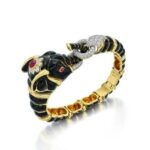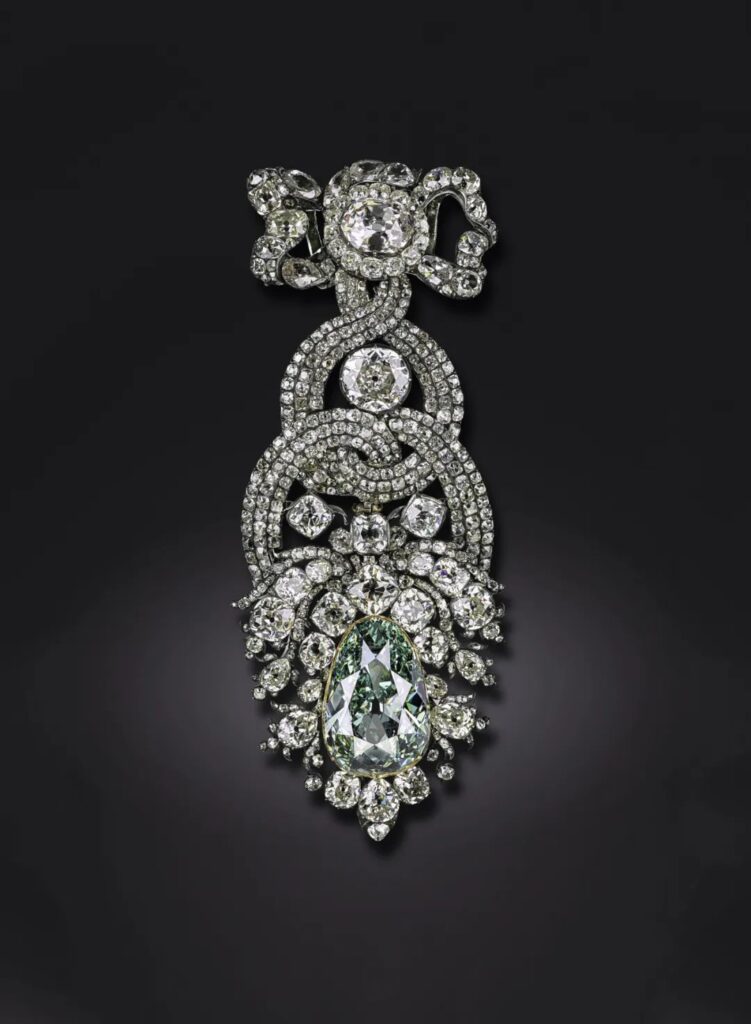
Do you remember the “Dresden Heist” that took place in 2019? Jewelry worth 1 billion euros was stolen at that time. Five years have passed, and fortunately, most of the jewels have been successfully recovered. As one of the largest treasure museums in Europe, how is the Green Vault doing now? Let’s take a look together!
Dresden, situated on the banks of the Elbe River, holds a special place in German history.
As the capital of the Saxon Electors, Dresden has gathered precious artworks from Europe and around the world, earning it the nickname “Florence on the Elbe.”
Among the many Saxon rulers, Augustus the Strong (1670-1733), known as the “Strong King,” made the greatest contribution to Dresden’s art collection. Based on his private collection in the royal palace, he created a series of museums open to the public, with the Green Vault, established in 1723, being the most prominent.
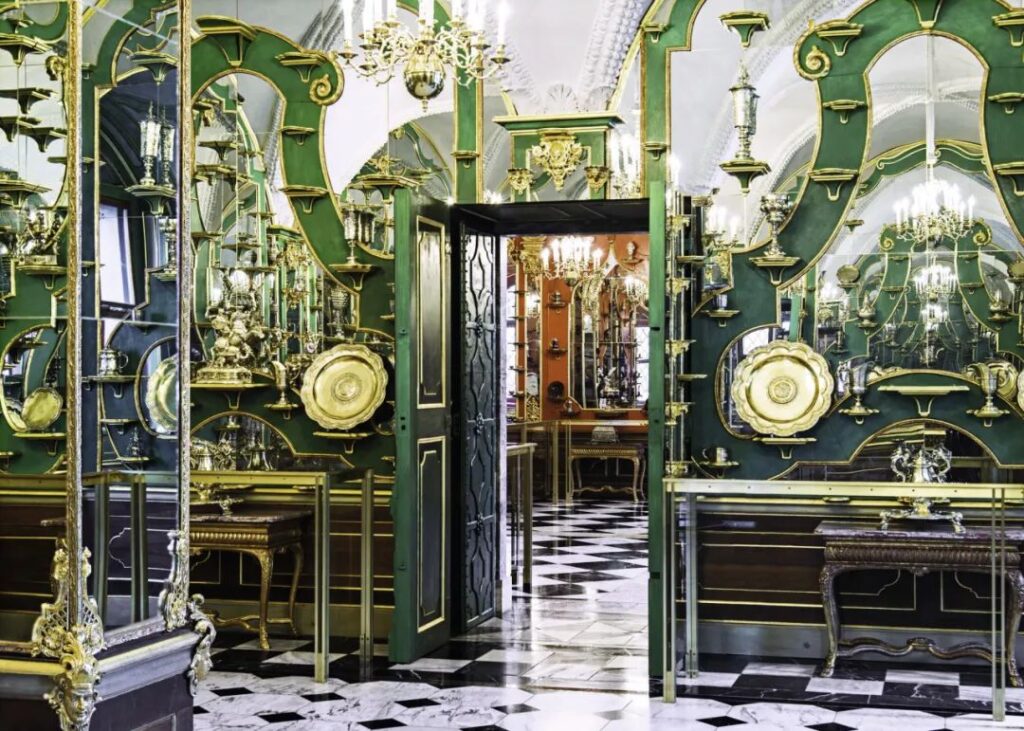
As one of the oldest large museums in the world, the Green Vault is located within the Dresden Palace complex. It is a typical Baroque-style building, named after its green dome, which can be easily recognized upon entering the old town.
Green appears not only on the roof and corner towers but is also extensively featured on the exterior walls, columns, reliefs, and interior decorations. The architecture, interior design, and the numerous collections all reflect the Baroque artistic dream that the “Strong King” persistently pursued.
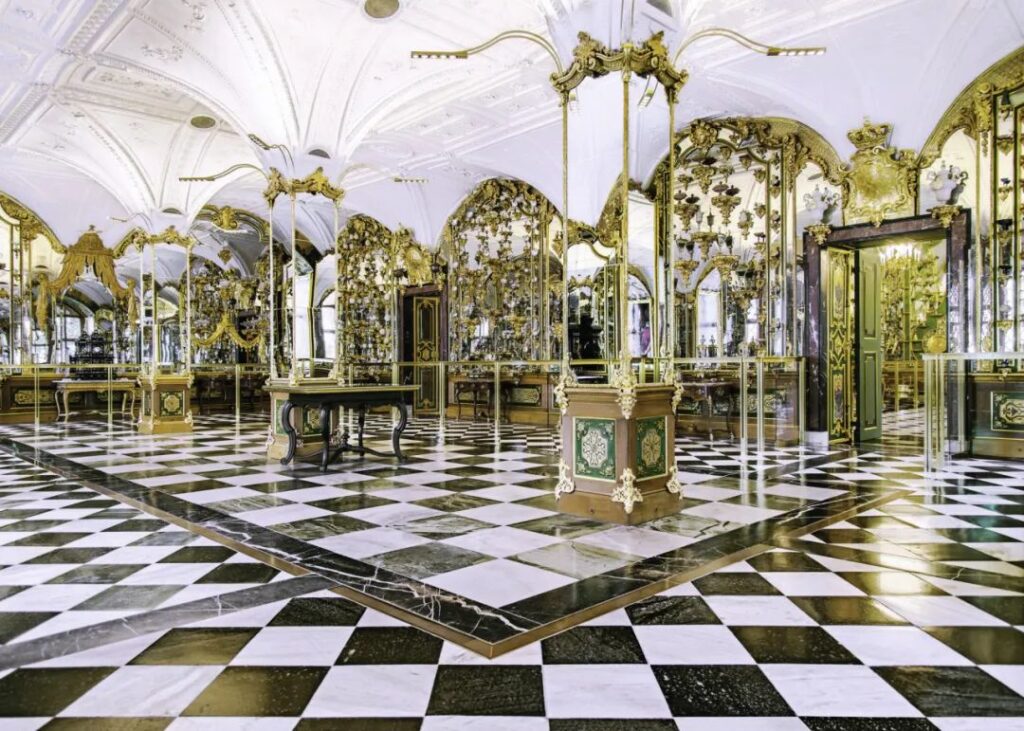
Today’s Green Vault has two floors. The ground floor is known as the old vault or historical collection hall. After passing through the entrance hall, there are nine independent themed exhibition rooms, including amber, ivory, silverware, gilded silver, rare objects, coats of arms, jewelry bronzes, and Renaissance bronzes, with a total of over 3,000 items.
The upper floor is the new vault, with a layout similar to the old vault. The exhibits are mostly rare treasures from the royal collection, totaling over 1,000 pieces.
Traveling through thousands of kilometers of space and time, spanning hundreds of years of human history, let’s appreciate the rare and luxurious collections in the Green Vault of Dresden Palace. These are not just priceless and luxurious giant diamonds and treasures, but also legendary anecdotes steeped in history.
The Largest Natural Green Diamond
The Dresden Green Diamond
The Dresden Green, weighing 40.7 carats, is believed to have originated from the famous diamond “cradle” – Golconda, India. Historical records suggest that in 1722, it was cut from a 119.5-carat rough stone in London. Named after Dresden, the former residence of electors and royalty, this diamond escaped the “Great Heist” as it was on loan elsewhere at the time.

The Dresden Green is not only enormous but also boasts a natural, bright apple-green color. It has an antique cut close to an almond shape. In 1741, Augustus III, Elector of Saxony and King of Poland, purchased it from Dutch diamond dealer Delles for the hefty sum of 400,000 Thalers. Interestingly, the construction of Dresden’s luxurious Frauenkirche around the same time cost only 288,000 Thalers.

Initially, Augustus III commissioned court jeweler Johann Friedrich Dinglinger to set this new “heirloom” in the Order of the Golden Fleece. By early 1746, another jeweler, Jean-Jacques Pallard, transformed it into an even more splendid piece, much to Augustus III’s delight.
In 1763, following the deaths of Augustus III and his son, 13-year-old Friedrich August became the heir, urgently needing jewelry to represent his status and power. He instructed jeweler Franz Michael Diespach to disassemble the existing set and other pieces for recombination.
In 1769, this magnificent hat ornament was created, blending Rococo style with early classical design language and incorporating aesthetic elements from traditional religious jewelry. It features two round brilliant-cut diamonds of 19.3 and 6.3 carats, along with 411 diamonds of various sizes, all complementing the star of the show – the gold-mounted Dresden Green Diamond.
The Audience of the Great Mogul Aurangzeb
This early 18th-century masterpiece is a massive, elaborate, and intricate installation art piece, measuring 142 cm in width and 58 cm in height.
“The Audience of the Great Mogul Aurangzeb” truly deserves its status as the Green Vault’s crown jewel. It’s like a vivid, three-dimensional drama, bringing to life the birthday celebration of the Indian Great Mogul Aurangzeb. Envoys from various countries are depicted riding elephants and camels or being carried in luxurious palanquins, respectfully presenting gifts to the emperor.
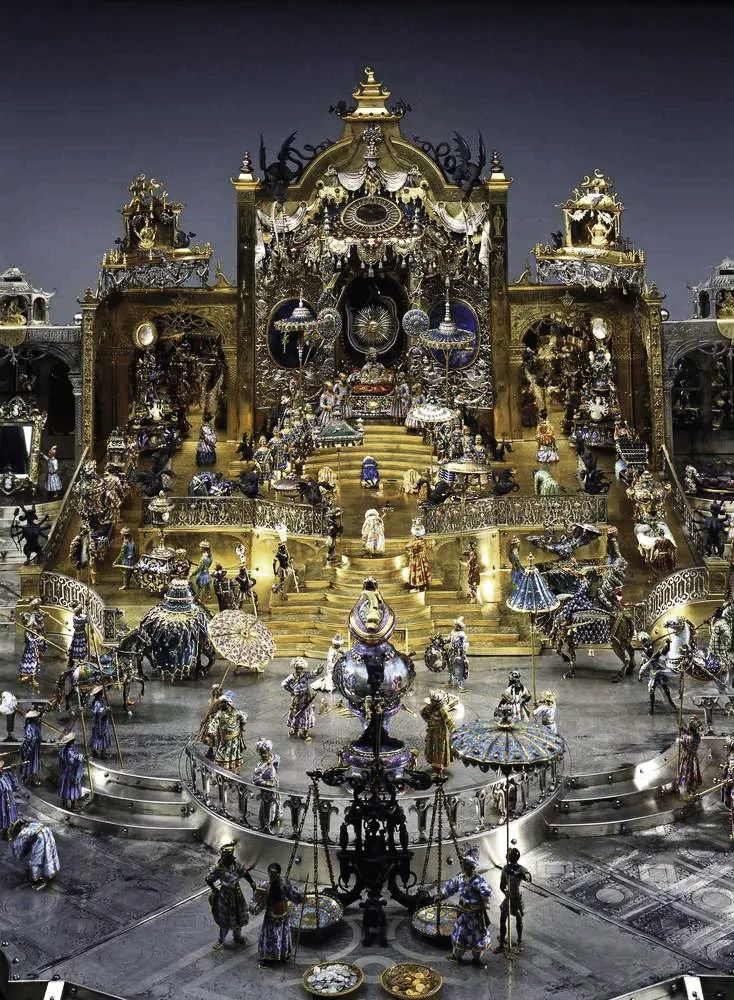
Court jeweler and Baroque master Dinglinger studied numerous historical images to create this piece. It incorporates customs and symbols from ancient Egypt, Greece, China, and even Germanic cultures. The work is adorned with 5,223 diamonds, 189 rubies, 175 emeralds, 53 natural pearls, 2 cameo reliefs, and 1 sapphire (391 gems and pearls are currently missing).
It also features 137 “little figures” created using gilding and enameling techniques. Remarkably, all the characters and objects can be “moved,” allowing for countless scene variations. It’s reminiscent of today’s large-scale Lego sets, truly representing the pinnacle of luxurious jewelry craftsmanship!
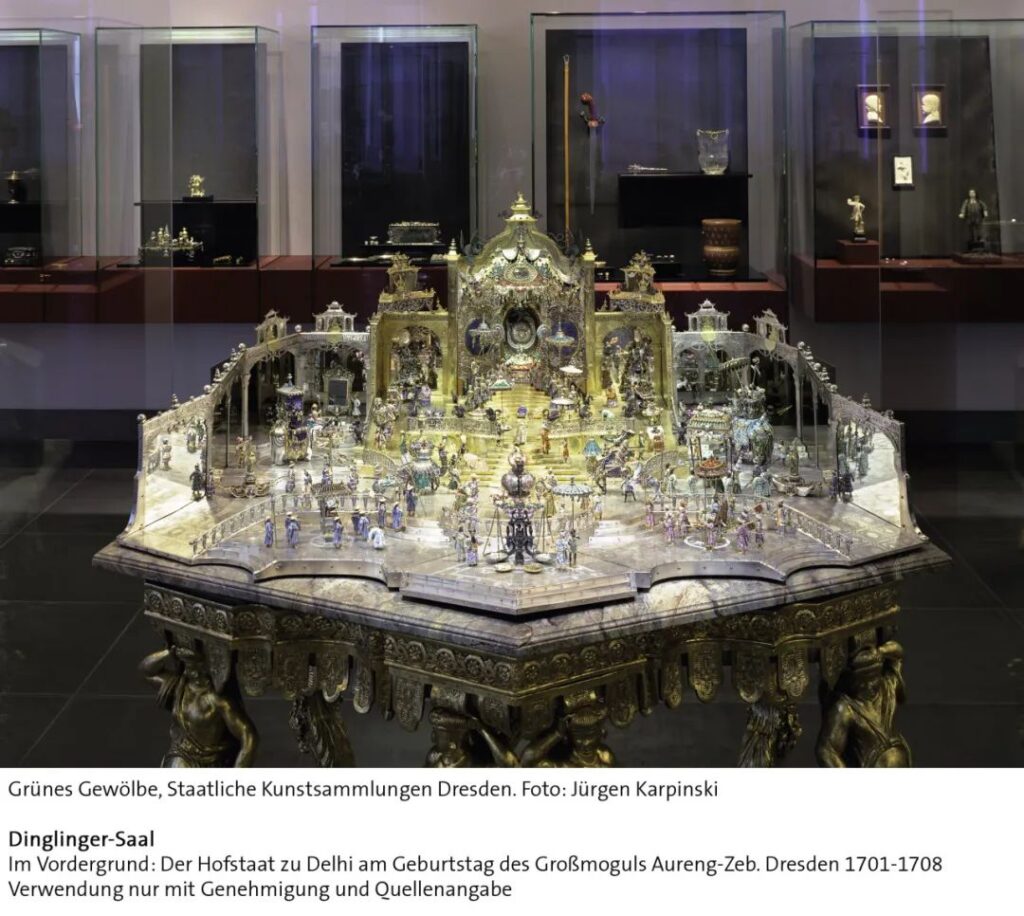
The “Strategic Ornament” on the Tricorn Hat
The Heron Diamond Aigrette
In the late 17th century, tricorn hats became popular in Europe. When this trend reached France, King Louis XIV, a fashion trendsetter, quickly made tricorn hats a fashionable item in the royal court. It’s well known that the “Strong King” Elector Augustus loved to follow French trends, and this tradition continued with his great-grandson Friedrich August I, who still looked to the French royal court for fashion inspiration.
Royal and noble tricorn hats were often made of beaver fur, typically in black, gray, or brown. Their brims were wider and more ornate than those worn by commoners. Such a prominent accessory naturally called for various strategic decorations.
Feather ornaments were once very popular, but how could even the most luxurious natural feathers compete with this brilliant aigrette adorned with 299 diamonds? This hat ornament stands nearly 15 centimeters tall. The court jeweler’s inspiration came from natural heron feathers, also drawing on traditional hat ornaments from the late Renaissance period.
A delicate bow extends into 9 long “spines,” with diamonds set in descending size. To maintain balance and stability, horizontal “diamond lines” serve as fixators. Examining the craftsmanship on the back of the ornament reveals hidden small springs, showcasing the complexity of the piece.
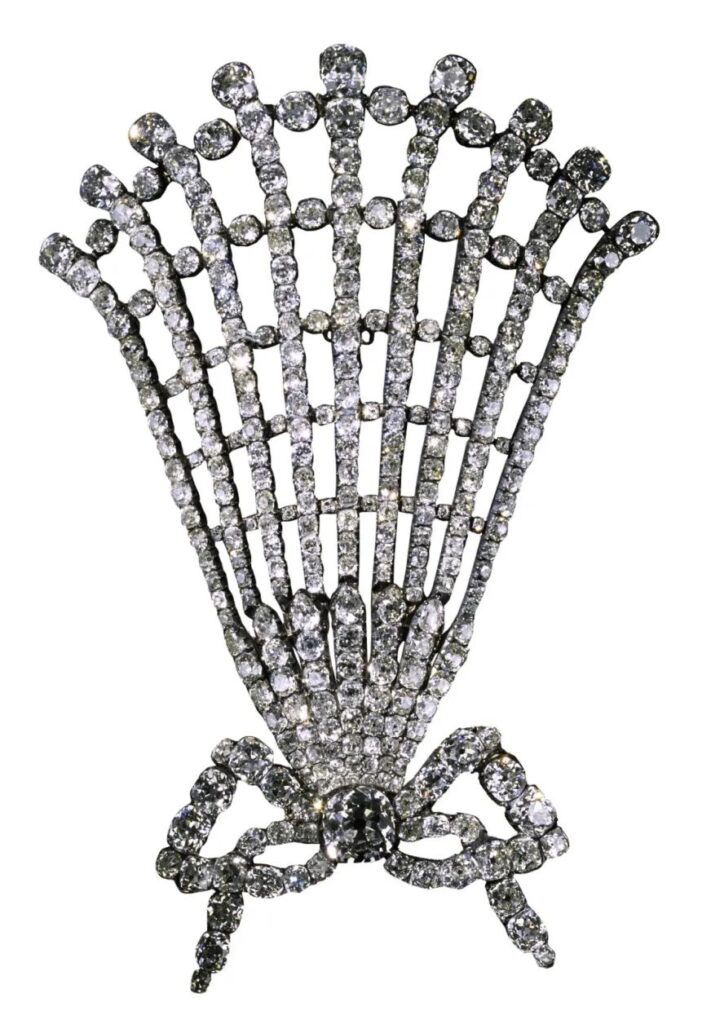
“Justice” Triumphs Over “Evil”
The St. George Slaying the Dragon Pendant
The story of St. George slaying the dragon is well-known, originating from ancient Greek mythology: A dragon often harassed a castle, and when the king’s daughter was chosen as the next sacrifice, God’s knight St. George suddenly appeared, vanquished the evil dragon, and saved the princess. This story has been passed down for thousands of years in various versions across West Asia and Europe, symbolizing the triumph of justice over evil.
This St. George slaying the dragon pendant dates back to around 1590 and was a small gift to Electress Sophia for the religious holiday of Maundy Thursday. It boasts rich and vibrant colors, with the white horse and green dragon crafted using intricate and vivid enamel techniques. The piece is further embellished with diamonds and emeralds.
Particularly notable are two shaped rubies with full cuts and intense colors. Even more remarkable is the inclusion of 7 natural pearls of various sizes.
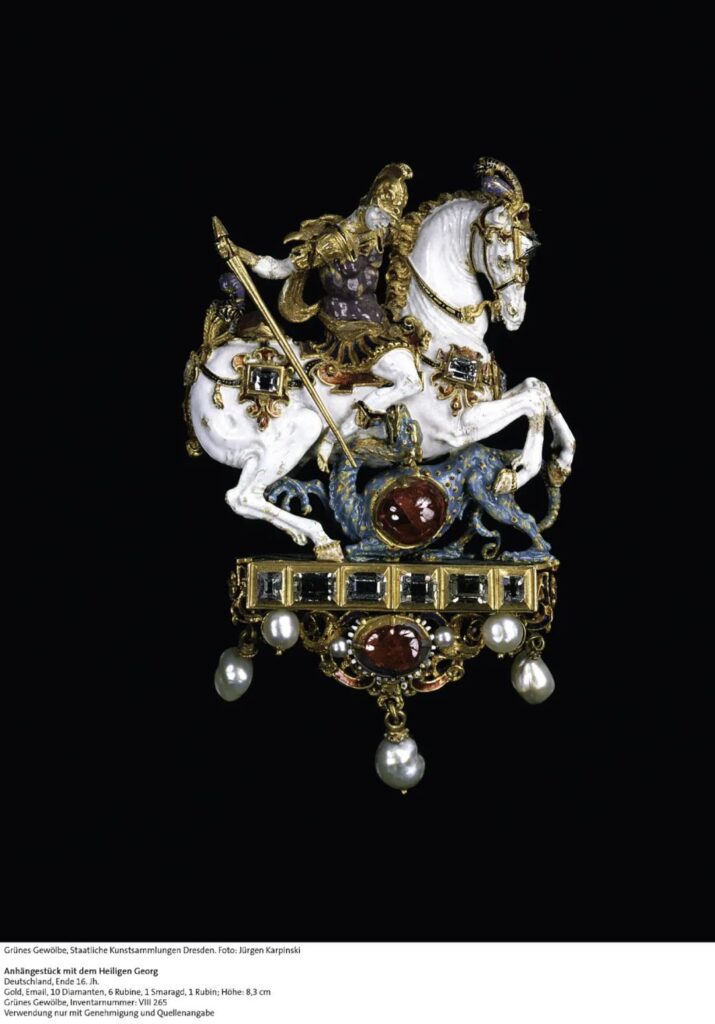
Even the King’s Sword Must Be “Bejeweled”
The Sapphire Set Clasp
During his youth, Augustus the Strong traveled extensively to France and Italy, broadening his horizons significantly. He particularly admired King Louis XIV of France. Upon inheriting the throne and gaining great power, he began implementing his own “small dreams,” inspired by French architecture, decorations, jewelry, and fashion.
From 1697 onwards, Augustus, as Elector of Saxony and King of Poland, envisioned and designed numerous sets of high-end jewelry for himself. This sapphire and diamond jewelry set was part of a larger collection. Even the king’s military attire for battle campaigns had to be resplendent with jewels.
The sword would be attached to a thick shoulder strap, and this clasp on the diagonal sash across the chest served both a practical purpose and a decorative one. It was essential to include jeweled ornaments to display the king’s authority and taste.
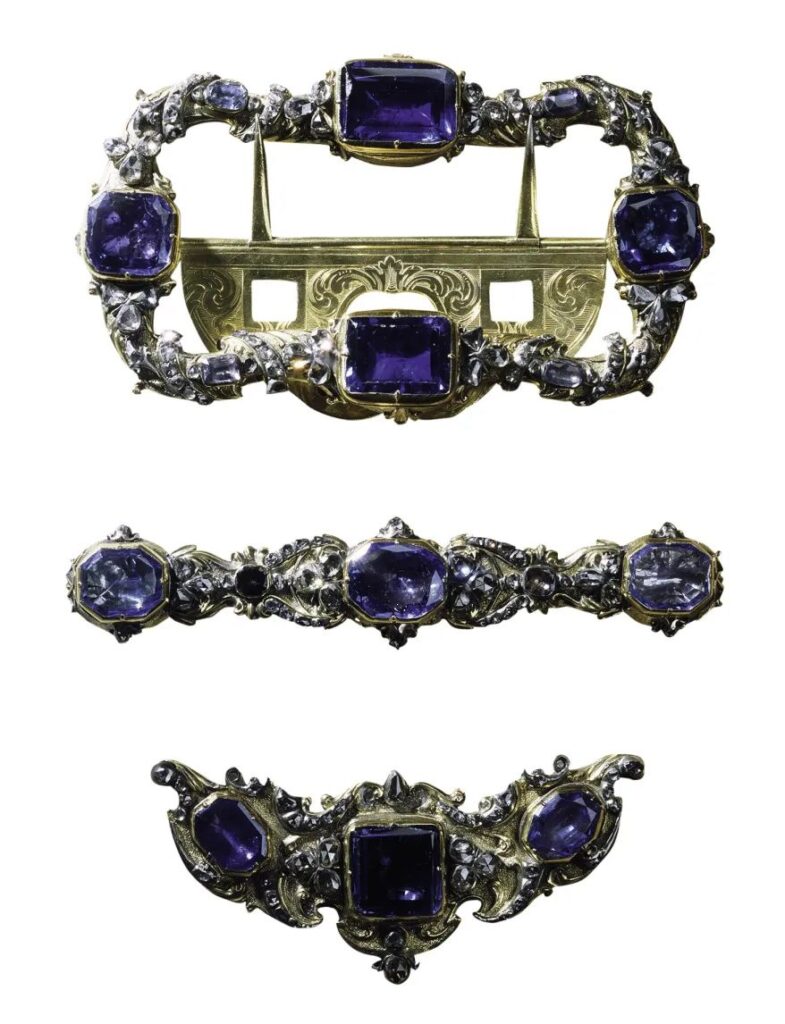
A “Mechanical Marvel” from Centuries Ago
The Octagonal Tower Globe Clock
This octagonal tower “structure” standing 1.12 meters tall is actually a giant globe clock. More precisely, it’s a complex mechanism combining musical functions and automated figurines. Remarkably, it was created in the distant year of 1600, truly a “mechanical marvel”!

On the hour, a crystal ball revolves around the tower-shaped clock 16 times within a full minute, while a second sphere is raised inside the case. Upon completion of this process, the hand moves forward, and Saturn’s small hammer strikes the bell.
Upon closer inspection, you’ll notice that the other planetary deities and the “musicians” on the lower balcony are not mere decorations. All their movements are directly related to the clock’s mechanism. The perpetual calendar engraved on the balcony floor is also movable and connected to the timekeeping. The seven liberal arts proposed by ancient Greek philosopher Plato – grammar, rhetoric, logic, music, astronomy, geometry, and arithmetic – are represented in niches on the base.
The crowned double-headed eagle and the Saxon ducal coat of arms both refer to Emperor Rudolf II, whose portrait appears below the dial alongside that of his friend, Saxon Elector Christian II, indicating the connection between these two avid collectors. This remarkable globe clock was crafted by the renowned mechanician and clockmaker Hans Schlottheim.

Q: If you were to describe the Green Vault in three words, what would be your most immediate impression?
A: “Magical, irresistible, and immeasurable.”
Q: The Green Vault’s exhibition is splendid and unique, especially in the “Historic Green Vault,” where priceless collections are openly displayed to visitors. What was the reasoning behind this approach?
A: “The museum’s original concept was developed in the early 18th century by Augustus the Strong and court architects. They reconstructed these halls and displayed the collections in a theatrical manner. Each room uses intense colors, luxurious materials, and numerous mirrors to enhance the sense of splendor and create mirror-like illusions.
As early as 1724, the ‘Green Vault’ halls were open to the public. As the king wished, people ‘wearing clean clothes’ could enter and visit, which remains true today, though with limited numbers.”
Q: The Green Vault sounds incredibly appealing, but distant “fans” cannot visit. Is there any good solution for this?
A: “In recent years, the ‘Green Vault’ has occasionally had to close temporarily, and visitor numbers have significantly decreased. This has encouraged us to advance new digital models and develop new virtual services. Now, friends visiting the ‘Green Vault’ can choose ‘online exhibitions’ on the official website. You can experience those priceless treasures up close as if you were there in person. Give it a try!”
For jewelry enthusiasts who love Baroque art style, a visit to the Green Vault is a must when traveling to Germany! In this museum housing over 3,000 artistic treasures, be sure to allow yourself enough time to carefully appreciate each piece. That concludes our museum sharing for today! How did you find it? Don’t forget to share this with your friends!
A Peek into Royal Treasures: Explore Europe’s Legendary Green Vault!
Tweet
